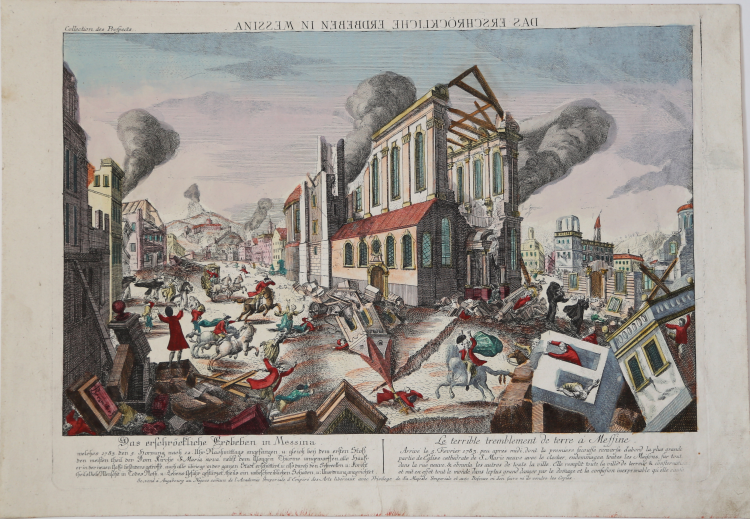


| Reference: | s29459 |
| Author | Georg Balthasar PROBST |
| Year: | 1785 |
| Zone: | Messina |
| Printed: | Augsburg |
| Measures: | 405 x 300 mm |


| Reference: | s29459 |
| Author | Georg Balthasar PROBST |
| Year: | 1785 |
| Zone: | Messina |
| Printed: | Augsburg |
| Measures: | 405 x 300 mm |
Curious optical view by Probst, depicting the devastating Messina earthquake that occurred in 1783.
Published in Augsburg in 1785.
The optical views are a particular genre of engravings, created to be inserted into a special machine that allowed the vision with a three-dimensional effect.
Copperplate, beautiful original colouring, in perfect condition.
Georg Balthasar PROBST (1732-1801)
|
Georg Balthasar Probst was a German artist, engraver and publisher in Augsburg, a major European publishing center in the 17th and 18th centuries. He produced architectural views of places around the world intended as vues d’optiques, which were published in various places during the last half of the 18th century, including Paris, Augsburg and London. He was also known for his portraits.
Probst came from an extended family of printers, whose businesses can all be traced back to the publishing firm of Jeremias Wolff (1663-1724). After Wolff's death his firm was continued as “Wolff’s Heirs” (Haeres Jer. Wolffii) by his son-in-law Johann Balthasar Probst (1689-1750). After Probst’s death in 1750, his descendants divided the business and published under their own imprints: Johann Friedrich Probst (1721-1781), Georg Balthasar Probst (1732-1801) and Johann Michael Probst.
Another part of the Wolff-Probst firm was acquired by the Augsburg publisher Johann Georg Hertel (1700-1775), whose son Georg Leopold Hertel had married a sister of the Probsts. In the next generation, Georg Mathäus Probst (d. 1788), son of Georg Balthasar Probst, also became an engraver of portraits and views.
|
Georg Balthasar PROBST (1732-1801)
|
Georg Balthasar Probst was a German artist, engraver and publisher in Augsburg, a major European publishing center in the 17th and 18th centuries. He produced architectural views of places around the world intended as vues d’optiques, which were published in various places during the last half of the 18th century, including Paris, Augsburg and London. He was also known for his portraits.
Probst came from an extended family of printers, whose businesses can all be traced back to the publishing firm of Jeremias Wolff (1663-1724). After Wolff's death his firm was continued as “Wolff’s Heirs” (Haeres Jer. Wolffii) by his son-in-law Johann Balthasar Probst (1689-1750). After Probst’s death in 1750, his descendants divided the business and published under their own imprints: Johann Friedrich Probst (1721-1781), Georg Balthasar Probst (1732-1801) and Johann Michael Probst.
Another part of the Wolff-Probst firm was acquired by the Augsburg publisher Johann Georg Hertel (1700-1775), whose son Georg Leopold Hertel had married a sister of the Probsts. In the next generation, Georg Mathäus Probst (d. 1788), son of Georg Balthasar Probst, also became an engraver of portraits and views.
|